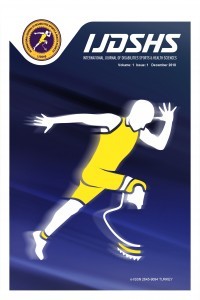Investigation of The Pain and Disability Situation of The Individuals Working "Home-Office" At Home At The Covid-19 Isolation Process
Investigation of The Pain and Disability Situation of The Individuals Working "Home-Office" At Home At The Covid-19 Isolation Process
Pain, Low Back, Shoulder Knee, Covid-19 isolation process,
___
- Ariens, G., Bongers, P., Hoogendoorn, W., Houtman, I.L.D., van der Wal, G., van Mechelen, W. (2001). High quantitative job demands and low coworker support as risk factors for neck pain: results of a prospective cohort study. Spine, 26:1896–901.
- Carayon, P., Smith, M. J. (2000). Work organization and ergonomics. Appl Ergon, 31(6), 649-662.
- Collins, N.J., Misra, D., Felson, D.T., Crossley, K.M., Roos, E. M. (2011). Measures of knee function. Arthritis Care Res, 63(S11), 208-228.
- Demure, B., Luippold, R., Bigelow, C., Danielle, A., Mundt, K.A., Bernhard, L. Video display terminal workstation improvement program: I. Baseline associations between musculoskeletal discomfort and ergonomic features of workstations. J Occup Environ Med 2000;42:783–91.
- Düger, T., Yakut, E., Öksüz, Ç., Yörükan, S., Bilgütay, B. S., Ayhan, Ç., Leblebicioğlu, G., Kayıhan, H., Kırdı, N., Yakut, Y., Güler, Ç. (2006). Kol, omuz ve el sorunları (disabilities of the arm, shoulder and hand-DASH) anketi Türkçe uyarlamasının güvenirliği ve geçerliği. Fizyoterapi Rehabilitasyon, 17(3), 99-107.
- Ellison, J. K. (2011). Ergonomics for telecommuters and other remote workers. In ASSE Professional Development Conference and Exposition. American Society of Safety Engineers.
- Eriksen, W., Natvig, B., Knardahl, S., Bruusgaard, D. (1999). Job characteristics as predictors of neck pain. A 4-year prospective study. J Occup Environ Med, 41:893–902.
- Fairbank, J.C., Couper, J., Davies, J.B., O'Brien, J.P. (1980). The Oswestry low back pain disability questionnaire. Physiotherapy, 66, 271-273.
- Fritz, J.M., Irrgang, J.J. (2001). A comparison of a modified Oswestry Low Back Pain Disability Questionnaire and the Quebec Back Pain Disability Scale. Phys Ther, 81, 776-788.
- Harrington, S. S., Walker, B. L. (2004). The effects of ergonomics training on the knowledge, attitudes, and practices of teleworkers. J Safety Res, 35(1), 13-22.
- Hartvigsen, J., Leboeuf-Yde, C., Lings, S., & Corder, E. H. (2000). Review Article: Is sitting-while-at-work associated with low back pain? A systematic, critical literature review. Scandinavian Journal of Public Health, 28(3), 230–239. https://doi.org/10.1177/14034948000280030201
- Hill, E. J., Ferris, M., & Märtinson, V. (2003). Does it matter where you work? A comparison of how three work venues (traditional office, virtual office, and home office) influence aspects of work and personal/family life. Journal of Vocational Behavior, 63(2), 220-241.
- Karakoyun, F. (2016). Home ofis-evden çalışma-yöntemi ve vergi hukukundaki düzenlemeler. Uluslararası Yönetim İktisat ve İşletme Dergisi, 12(29), 141-162.
- Kwong, W.J., Pathak, D.S. (2007). Validation of the eleven-point pain scale in the measurement of migraine headache pain. Cephalalgia, 27(4), 336-342.
- Roffey, D. M., Wai, E. K., Bishop, P., Kwon, B. K., & Dagenais, S. (2010). Causal assessment of occupational sitting and low back pain: results of a systematic review. The Spine Journal, 10(3), 252-261.
- Shannon, H., Woodward, C., Cunningham, C., McIntosh, J., Lendrum, B., Brown, J., & Rosenbloom, D. (2001). Changes in general health and musculoskeletal outcomes in the workforce of a hospital undergoing rapid change: a longitudinal study. J Occup Health Psychol, 2001;6:3–14.
- Szeto, G. P., & Lam, P. (2007). Work-related musculoskeletal disorders in urban bus drivers of Hong Kong. Journal of occupational rehabilitation, 17(2), 181-198.
- Tittiranonda, P., Burastero, S., Rempel, D. (1999). Risk factors for musculoskeletal disorders among computer users. Occupational Medicine: State of the Art Reviews,14:17–38.
- Yayın Aralığı: Yılda 3 Sayı
- Başlangıç: 2018
- Yayıncı: Nevzat DEMİRCİ
Pınar KAYA CİDDİ, Elif Aleyna YAZGAN
Meltem KOÇ, Özge İPEK DONGAZ, Banu BAYAR, Kılıçhan BAYAR
Elif DİNLER, Tuğba BADAT, Deniz KOCAMAZ, Yavuz YAKUT
Eren ŞAHİN, Ahmet Onur ÖZ, Rabia Hürrem ÖZDURAK SINGIN, Serkan DÜZ
Analysis of Researches on Individuals with Special Needs and Their Academic Successes
Aytekin Hamdi BAŞKAN, Ayşenur ORAL, Fırat DEMİROĞLU, Gözde KELEŞ
Telerehabilitation During the COVID-19 Pandemic: Why and How?
Nihan ÖZÜNLÜ PEKYAVAŞ, Engin PEKYAVAS
İbrahim KURT, Mürsel AKDENK, Mehmet AKBULUT, Mustafa Kemal KURT
